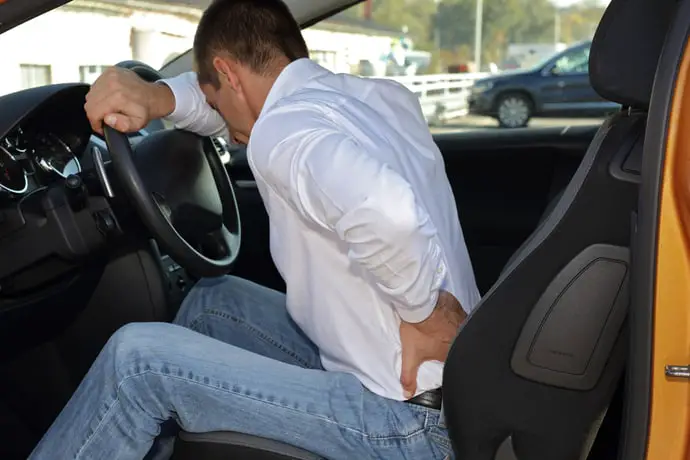Last Updated on August 26, 2022 by

Driving a car is a necessary part of almost everyone’s life. Some people are lucky enough that they mostly drive short distances but many people spend a lot of time behind the wheel. Inevitably, sitting still and having bad posture while driving will lead to discomfort in your neck and back. However, there are steps that you can take to minimise or even prevent it from happening.
Adjust the Seat and Mirrors Properly
What’s comfortable and what’s best for you aren’t always the same thing but you should be able to achieve both if your seat and mirrors are adjusted properly. The backbone is meant to move with the body and being stuck in one position for long periods of time leads to back pain. Drivers who spend four or more hours behind the wheel on a daily basis are most likely to suffer this kind of pain.
Fortunately, there are different ways to prevent this from happening. Having your seat and mirrors adjusted in the correct position for your body is critical. Here are tips on how to make sure that your car is set up to be a perfect fit for you.
Adjust the seat to allow full contact
Make sure that your back is in complete contact with your seat from your shoulders to the base of your spine. Most cars have multiple buttons for adjustments and you should be able to find the position that is perfect for your body.
Move it forward
When your seat is too far back, you have to lean forward to reach the steering wheel. Move your seat forward as far as you can so that you can rest against the seat and comfortably hold the steering wheel.
Seat angle
Your seat should be set so that your body is at an angle of 100 to 110 degrees. Leaning too far back or forward puts a strain on your back and leads to inflammation and discomfort.
Adjust your mirrors
Your side and rear view mirrors should be set so that you do not need to do more than glance at them. You don’t want to lean forward or twist your neck to look in the mirror.
Adjust the headrest
Your headrest should be set so that the middle of your head rests comfortably against it. Don’t lean back into the headrest; if the seat is adjusted properly, it will provide vital support to ease the strain on your neck and back.
Set your steering wheel
You should be able to grip your steering wheel without reaching. If you have armrests, you should be able to comfortably rest your arms on them while you are driving. Contrary to former thinking, new studies suggest that you should grip the steering wheel at the 3:00 and 9:00 positions as this is a more natural position for your body.
Raise your seat
Your seat should be raised so that you can look straight ahead and see the road. If you sit too low, you will have to shift your position to see, which will lead to discomfort in your back and neck.
Posture, Exercise, and Preventative Care
Having good posture is important in general but it is especially necessary when you are driving. The back is the basis of movement in the human body and it helps or hinders people in all aspects of life. Good posture is not limited to standing and moving around; it also includes sitting, especially sitting for long periods of time. Achieving consistent good posture is not always easy but it can be done with a conscious effort.
Lumbar Support
If you find that your seat is unable to support your lower back, use lumbar support. Keep your tailbone as close to the back of the seat as possible and place a lumbar cushion or even a rolled towel between your lower back and the seat. The spine has a naturally “S”-curved shape and lumbar support will help to hold your spine in the correct position for good posture.
Cruise Control
If you are able to use cruise control, do so. You can place your feet in front of you and distribute your weight evenly to keep your body correctly aligned. The more you can do to keep your body in its correct position, the more you will prevent or minimise back pain.
Exercise
Exercise to strengthen your core and your back as this will help you maintain good posture. Incorporate regular activities that are designed to build core strength into your daily life. You can do them at home or even join a fitness class at a gym. This will not only help to prevent back pain but it will add to your overall health.
Ice Packs
If you already have back pain, use ice. You can buy portable ice packs for a long trip, which will ease your discomfort a great deal. Back pain is almost always the result of inflammation and ice is an amazing anti-inflammatory. Apply the ice packs for 20 minutes at a time and it should help you manage your pain a great deal.
Heated/Cooled Seats
If your car has heated or cooled seats, turn this feature on. The cooling reduces inflammation and heat relaxes tension and loosens tight muscles. Whether you want to prevent back pain or you are already experiencing it, this feature in your car can help.
Stretch
If you are driving long distances, try to stop at least once every thirty minutes or so. Get out of the car, stretch, and go for a walk. Remember that your back is designed to move and staying still for long periods of time will lead to discomfort.
These are little adjustments that you can make to improve the way you drive. Make it a priority to have your seat and mirrors adjusted such that your body is in a more natural position without straining or leaning. Take breaks and use good posture. Back pain can be debilitating but you can take these steps to minimise and prevent it.
